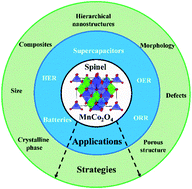Multifunctional spinel MnCo2O4 based materials for energy storage and conversion: a review on emerging trends, recent developments and future perspectives
Abstract
The energy requirement of modern society increases every day. The depletion of the reserves of fossil fuel combined with the deleterious effects of CO2 in the atmosphere is forcing all the world to search for alternative ways of generation and storing energy. Many scientists around the world are pursuing different forms to produce and store energy. Solar and wind sources are a reality for production of electricity, but are not continuous and require storage devices. The development of batteries and hybrid supercapacitors of high energy and power density is of great importance to complement this requirement of energy storage. Rechargeable metal–air batteries which utilize oxygen electrocatalysis seem to be an ideal choice, once the source of energy is not intermittent as solar and wind energy and is based on oxygen bifunctional electrocatalysis of both oxygen reduction and O2 evolution reactions. In addition, water splitting allows the conversion and storage of solar/wind energy into chemical energy, generating fuels with high energy content. From this perspective, spinel MnCo2O4-based materials are promising structures for energy storage and conversion of energy. In this review, the use of low cost and abundant multifunctional materials for the development of supercapacitor devices and batteries was summarized. Completely, the design of electrocatalysts for water splitting and their capability to proportionate the tetra-electronic process of the oxygen reduction reaction are reviewed, including the main strategies in the preparation of these materials and considering their key multifunctional role in the way to a more sustainable society.

- This article is part of the themed collection: Editor’s Choice 2023: Advancing electrocatalysts for a sustainable future.


 Please wait while we load your content...
Please wait while we load your content...